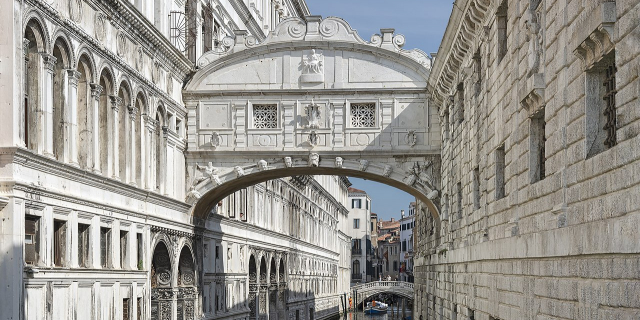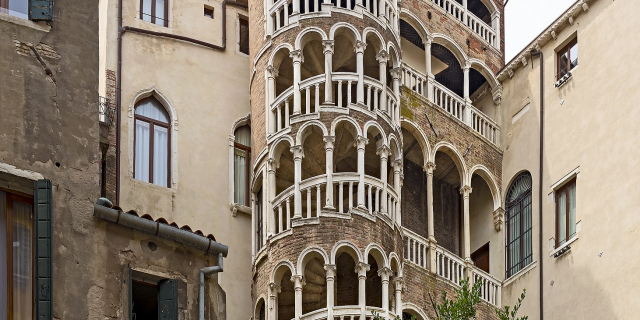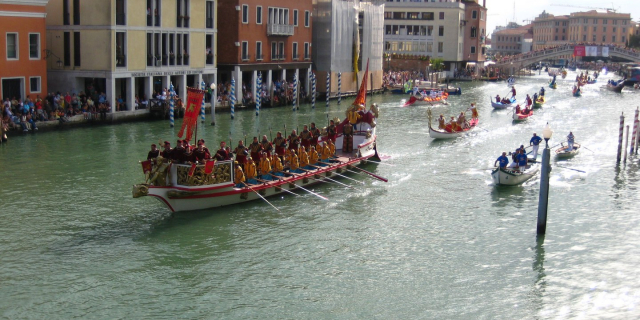St Mark's Campanile (Italian: Campanile di San Marco, Venetian: Canpanièl de San Marco) is the bell tower of St Mark's Basilica in Venice, Italy. The current campanile is a reconstruction completed in 1912, the previous tower having collapsed in 1902. At 98.6 metres (323 ft) in height, it is the tallest structure in Venice and is colloquially termed "el paròn de casa" (the master of the house). It is one of the most recognizable symbols of the city.
Located in Saint Mark's Square near the mouth of the Grand Canal, the campanile was initially intended as a watchtower to sight approaching ships and protect the entry to the city. It also served as a landmark to guide Venetian ships safely into harbour. Construction began in the early tenth century and continued sporadically over time as the tower was slowly raised in height. A belfry and a spire were first added in the twelfth century. In the fourteent...Read more
St Mark's Campanile (Italian: Campanile di San Marco, Venetian: Canpanièl de San Marco) is the bell tower of St Mark's Basilica in Venice, Italy. The current campanile is a reconstruction completed in 1912, the previous tower having collapsed in 1902. At 98.6 metres (323 ft) in height, it is the tallest structure in Venice and is colloquially termed "el paròn de casa" (the master of the house). It is one of the most recognizable symbols of the city.
Located in Saint Mark's Square near the mouth of the Grand Canal, the campanile was initially intended as a watchtower to sight approaching ships and protect the entry to the city. It also served as a landmark to guide Venetian ships safely into harbour. Construction began in the early tenth century and continued sporadically over time as the tower was slowly raised in height. A belfry and a spire were first added in the twelfth century. In the fourteenth century the spire was gilded, making the tower visible to distant ships in the Adriatic. The campanile reached its full height in 1514 when the belfry and spire were completely rebuilt on the basis of an earlier Renaissance design by Giorgio Spavento. Historically, the bells served to regulate the civic and religious life of Venice, marking the beginning, pauses, and end of the work day; the convocation of government assemblies; and public executions.
The campanile stands alone in the square, near the front of St Mark's Basilica. It has a simple form, recalling its early defensive function, the bulk of which is a square brick shaft with lesenes, 12 metres (39 ft) wide on each side and 50 metres (160 ft) tall. The belfry is topped by an attic with effigies of the Lion of St Mark and allegorical figures of Venice as Justice. The tower is capped by a pyramidal spire at the top of which there is a golden weather vane in the form of the archangel Gabriel.
 The Nona and the Trottiera
The Nona and the TrottieraA bell was most likely first installed in the tower during the tenure of Doge Vitale II Michiel. However, documents that attest to the presence of a bell are traceable only from the thirteenth century. A deliberation of the Great Council, dated 8 July 1244, established that the bell to convene the council was to be rung in the evening if the council was to meet the following morning and in the early afternoon if the meeting was scheduled for the evening of the same day. There is a similar reference to the bell in the statute of the ironmongers' guild, dating to 1271.[1]
Over time, the number of bells varied. In 1489, there were at least six. Four were present in the sixteenth century until 1569 when a fifth was added. Beginning in 1678 the bell brought to Venice from Crete after the island was lost to the Ottoman Turks, called the Campanon da Candia, hung in the tower, but it fell to the floor of the belfry in 1722, and was not resuspended. After this time, five bells remained.[2] These were named (from smallest to largest) Maleficio (also Renghiera or Preghiera), Trottiera (also Dietro Nona), Meza-terza (also Pregadi), Nona, and Marangona.[3][4][5][note 1]
The historical accounts of the damage to the tower caused by lightning make reference to broken bells, an indication that the bells must have been recast at various times. Nonetheless, the first documented instance concerns the Trottiera, which was recast in 1731. The resulting sound was unsatisfactory, and the bell had to be recast two more times before it harmonized with the older bells.[6] After the designation of St Mark's Basilica as the cathedral of Venice (1807), the Marangona and Renghiera, together with the Campanon da Candia and other bells from former churches, were recast by Domenico Canciani Dalla Venezia into two larger bronze bells between 1808 and 1809, but these were melted with the Meza-terza, Trottiera, and Nona in 1820, again by Dalla Venezia, to create a new series of five bells.[7] Of these bells, only the Marangona survived the collapse of the bell tower in 1902.[8]
Cite error: There are <ref group=note> tags on this page, but the references will not show without a {{reflist|group=note}} template (see the help page).

































Add new comment